Making a Polytarp Sail
by David
"Shorty" Routh
Making the sail
This is another easy set of techniques
that I have found for making polytarp
sails. Please note that it isn't the "best", but rather
just another set of methods for making tarp sails. There are
many, many different techniques that you can employ when making
the sails, you need to decide for yourself which ones you employ.
And since the sails are so easy to make, have fun and experiment
around with different ideas.
For this sail, I wanted to do
the technique where the original edge of the polytarp is used,
and then make a "mother dart" to create the shape
of the sail. Jim Michalak has some great essays
on making sails in this method, he also has accurate calculations
on exactly how big the darts should be.
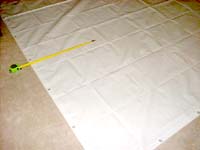 I
started off by moving all of the furniture out of my livingroom
so I could have some clear workspace. Notice the white tarp,
this sail was being made for a fiberglass sailboat that I wanted
to resell, so I bought a higher grade of white tarp from Dave
Gray at PolySail.com.
It is much stronger than the blue stuff you can get at the local
store, also it looks more normal like a dacron sail.
I
started off by moving all of the furniture out of my livingroom
so I could have some clear workspace. Notice the white tarp,
this sail was being made for a fiberglass sailboat that I wanted
to resell, so I bought a higher grade of white tarp from Dave
Gray at PolySail.com.
It is much stronger than the blue stuff you can get at the local
store, also it looks more normal like a dacron sail.
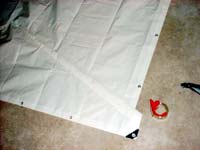 Knowing
the dimensions of my sail, I found where I wanted the center
of the draft to be and marked it.
Knowing
the dimensions of my sail, I found where I wanted the center
of the draft to be and marked it.
Folding a dart over from the
tack area, the dart ends at the point I previously marked. I
am not a very good seamstress, but have noticed that the secret
to sewing seems to be marking your work accurately, and pinning
it in place. A trick I picked up from Bill Tosh at TCBoats.com
is to use clear packing tape to hold the seams. You can easily
sew right thru the packing tape, and pull the tape off later.
Some people use duct tape and then sew thru it, but I have heard
the duct tape will grab the needle, so you have to grease it
up with vaseline often, and be careful.
 With
the dart held in place, I can mark the rest of the sail. I just
drew straight lines from the head and tack, back to the clew.
Many people will make a small inside curve on the leech of the
sail, this is called "hollowing out the leech". It
will prevent the leech from fluttering in the wind. I just made
a straight line, it won't flutter (atleast won't flutter that
much).
With
the dart held in place, I can mark the rest of the sail. I just
drew straight lines from the head and tack, back to the clew.
Many people will make a small inside curve on the leech of the
sail, this is called "hollowing out the leech". It
will prevent the leech from fluttering in the wind. I just made
a straight line, it won't flutter (atleast won't flutter that
much).
 To
sew the dart, you have to do something with all the extra material
on the the sewing machine side of the sail. I roll it up on
the top side, so I can feed it thru and sew one side of the
dart. Then pull it out, and feed thru again and sew the other
side of the dart.
To
sew the dart, you have to do something with all the extra material
on the the sewing machine side of the sail. I roll it up on
the top side, so I can feed it thru and sew one side of the
dart. Then pull it out, and feed thru again and sew the other
side of the dart.
A mistake I made when I first
started sewing was to bunch the material up instead. What happened
is that a loose flap of material went right under the sewing
foot attaching it to the dart. Had to cut the threads loose,
and re-sew it again.
| For the foot and leech, I
need to fold the edges over twice and then tape them into
place. Doing it free hand is rather difficult to create
a straight edge. One technique is shown here, you stretch
the material between two solid places, then fold and tape. |
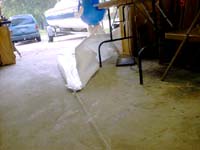 |
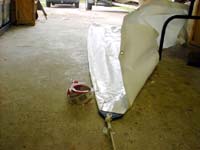 |
Looking at it from this
angle, I have created a little bit of curvature to the
edge, but it was simple and fast. Taping down the seam
with more packing tape, then run the edge thru the sewing
machine.
Repeat for the leech. |
| Since the original edge of
the polytarp has grommets in it, and I used that edge for
the luff, with the head ending at a grommet, the only thing
left to do on the sail is make the clew. |
|
|
I took a scrap piece of tarp
that had a grommet in it, and folded it, then sewed onto
the clew of the sail. Not only does it make a grommet for
me to attach the sprit to, but it forms a reinforcement
patch to strengthen that corner of the sail. |
Mounting the sail
| There are many types of snotters,
this is one very simple type. It is just a snap clip that
is laced to the mast, and the lacings are held in place
by a small cable clamp. You could also keep the lacings
there by running one thru a grommet on the sail. |
|
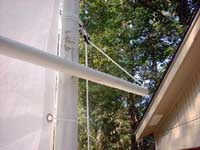 The
end of the sprit boom has the snotter line permanently attached
to it, this line is pulled back thru the snap clip and then
goes down. The tension you put on this line controls the tension
on the sail, and how flat the sail will be when sailing. If
you loosen the line, the sail will have a more fuller shape,
if you tighten it, the sail goes flatter.
The
end of the sprit boom has the snotter line permanently attached
to it, this line is pulled back thru the snap clip and then
goes down. The tension you put on this line controls the tension
on the sail, and how flat the sail will be when sailing. If
you loosen the line, the sail will have a more fuller shape,
if you tighten it, the sail goes flatter.
| Down to a cleat on the mast.
This sail rig is free standing, and can completely rotate
in the mast socket. If the mast doesn't rotate, then the
snotter will get tighter or looser depending on where the
line is cleated. |
|
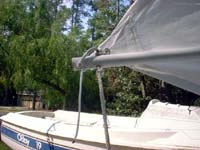 The
clew and aft end of the boom are simple, just 2 lines are taken
thru the boom. One is the outhaul from the sail, and the other
is the main sheet. Both are just tied thru the boom. You really
can combine these, the only reason I had them seperate is because
I swapped main sheets around.
The
clew and aft end of the boom are simple, just 2 lines are taken
thru the boom. One is the outhaul from the sail, and the other
is the main sheet. Both are just tied thru the boom. You really
can combine these, the only reason I had them seperate is because
I swapped main sheets around.
Notice that there is no hardware
on the boom, so during storage there are no metal fittings to
rust and damage the sail. Also nothing to scratch your body
as you set and take down the boom.
| Dousing the sail is very easy and quick.
Just release the snotter line and point the loose end of
the boom towards the head of the sail. |
|
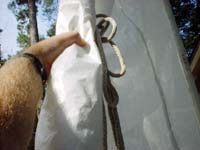 |
Start wrapping it up, and tuck the main
sheet in there. |
| Keep rolling .... |
 |
 |
With a bungee, the sail is completely
stowed away. |
| The last problem to solve is where do
you store such a long mast? This is my favorite solution
so far, haning from the garage ceiling. |
|
 With
the far end of the mast supported by a ceiling hook, the other
end is supported by mounting a line to the ceiling as close
to the open garage door as you can. Then just lift up the hook
on the line, put around the mast and presto the mast is put
away.
With
the far end of the mast supported by a ceiling hook, the other
end is supported by mounting a line to the ceiling as close
to the open garage door as you can. Then just lift up the hook
on the line, put around the mast and presto the mast is put
away.
Before I heard about this technique,
I used to use a pair of ceiling hooks, but the only way I could
get it up there was to close the garage door. I found myself
opening the garage door to get the boat out, then closing it
to get the mast down, open to go load it on the car.... Was
rather funny, every trip to the lake involved so many garage
door opening cycles. :)
NOT JUST FOR PDRACERS
And to prove that the mutton isn't just for home made sailboats,
here are a few links to commercial boats that use the mutton:

